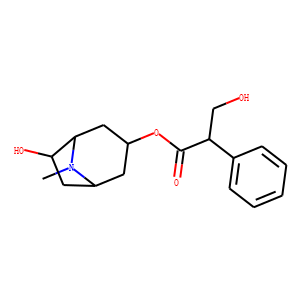| Overview of Clinical Research | The clinical phase 2 study was completed. The study was to evaluate efficacy , safety and feasibility of targeted intracoronary injection using pro-urokinase combined with anisodamine versus thrombus aspiration in ST-elevation myocardial infarction patients with thrombus loads.
<p class="document__title hotspot-element" id="trialID" style="font-size: 3rem; margin: 7px 0px 14px; font-family: Georgia, "New Century Schoolbook", "Nimbus Roman No9 L", serif; font-weight: normal; letter-spacing: 0.02em; line-height: 1.2; word-break: break-word; caret-color: rgb(51, 51, 51); color: rgb(51, 51, 51);">
<span style="font-size: 14px; font-family: arial, helvetica, sans-serif; color: rgb(34, 34, 34);"> </span></p>
|
| Reference | 1. Br J Pharmacol. 2016 Jun;173(11):1719-27. doi: 10.1111/bph.13486. Epub 2016 Apr 22.<br />
Possible role for anisodamine in organophosphate poisoning.<br />
Eisenkraft A(1)(2)(3), Falk A(1).<br />
Author information:<br />
(1)Israel Ministry of Defense, HaKirya, Tel Aviv, Israel. (2)Israel Defense Force Medical Corps, Ramat Gan, Israel. (3)The Institute for Research in Military Medicine, The Faculty of Medicine, The Hebrew University, Jerusalem, Israel.<br />
In cases of organophosphate poisoning, patients are treated with a combination of antidotes. In addition to these poison-directed antidotes, patients may require extra oxygen and artificial ventilation; other modalities may also be needed due to the wide range of toxic effects. Anisodamine is a belladonna alkaloid, and like other drugs from this family is non subtype-selective muscarinic, and a nicotinic cholinoceptor antagonist, which has been employed in traditional Chinese medicine. As a muscarinic antagonist, it displays similar pharmacological effects to atropine and scopolamine. However, anisodamine is not only less potent than atropine and scopolamine but also less toxic. Current in vitro and animal model studies have demonstrated that anisodamine has protective effects in a variety of diseases. Organophosphate poisoning involves not only the central and peripheral nervous systems, but also the cardiac and respiratory systems, as well as activation of inflammatory processes and oxidative stress. Therefore, the anticholinergic and additional activities of anisodamine appear to be relevant and justify its consideration as an addition to the existing remedies. However, more research is needed, as at present data on the role of anisodamine in the management of organophosphate poisoning are limited. Here, we review the beneficial effects of anisodamine on processes relevant to organophosphate poisoning.<br />
<br />
2. J Appl Toxicol. 2007 Mar-Apr;27(2):116-21.<br />
The pharmacological properties of anisodamine.<br />
Poupko JM(1), Baskin SI, Moore E.<br />
Author information:<br />
(1)Physician Assistant Branch, Department of Medical Sciences, AMEDD Center and School, Ft. Sam Houston, Texas 78234, USA. [email protected]<br />
Anisodamine is a naturally occurring atropine derivative that has been isolated, synthesized and characterized by scientists in the People's Republic of China. Like atropine and scopolamine, anisodamine is a non-specific cholinergic antagonist exhibiting the usual spectrum of pharmacological effects of this drug class. It appears to be less potent and less toxic than atropine and displays less CNS toxicity than scopolamine. Anisodamine has been shown to interact with and disrupt liposome structure which may reflect its effects on cellular membranes. Experimental evidence implicates anisodamine as an anti-oxidant that may protect against free radical-induced cellular damage. Its cardiovascular properties include depression of cardiac conduction and the ability to protect against arrhythmia induced by various agents. Anisodamine is a relatively weak alpha(1) adrenergic antagonist which may explain its vasodilating activity. Its anti-thrombotic activity may be a result of inhibition of thromboxane synthesis. The T(1/2) of anisodamine in humans is about 2-3 h. Numerous therapeutic uses of anisodamine have been proposed including treatment of septic shock, various circulatory disorders, organophosphorus (OP) poisoning, migraine, gastric ulcers, gastrointestinal colic, acute glomerular nephritis, eclampsia, respiratory diseases, rheumatoid arthritis, obstructive jaundice, opiate addiction, snake bite and radiation damage protection. The primary therapeutic use of anisodamine has been for the treatment of septic shock. Several mechanisms have been proposed to explain its beneficial effect though most mechanisms are based upon the assumption that anisodamine ultimately acts by an improvement of blood flow in the microcirculation. Preliminary studies suggest another important therapeutic use of anisodamine is for the treatment of OP poisoning. Additional research is needed to delineate further the clinical usefulness of anisodamine relative to other anti-muscarinic drugs such as atropine and scopolamine.<br />
<br />
3. J Nat Toxins. 1999 Oct;8(3):327-30.<br />
Anisodamine as an effective drug to treat snakebites.<br />
Li QB(1), Pan R, Wang GF, Tang SX.<br />
Author information:<br />
(1)Emergency Department of the 1st Affiliated Hospital, Guangxi Medical University, Nanning, P. R. China.<br />
Anisodamine is a natural alkaloid drug isolated from the plant Anisodus tanguticus growing in western China. The chemical structure and pharmacological action are just like the cholinergic receptor blocking agents atropine or scopolamine. The specific characteristic of the drug is being able to relieve the dangerous situation of microcirculatory failure, especially in case of DIC or renal failure. The prognosis of the patients will be quite good. Another characteristic of the drug is that no serious toxic reaction occurs even in successive doses given intravenously up to 500 mg a day. This is about fifty times greater than a common dose of 10 mg. Since we begin with the drug as a routine medication for the symptomatic treatment of renal failure, DIC bleeding, and microcirculatory failure, we should say that the specific antivenin and anisodamine are two treasure drugs for snakebites.
|

